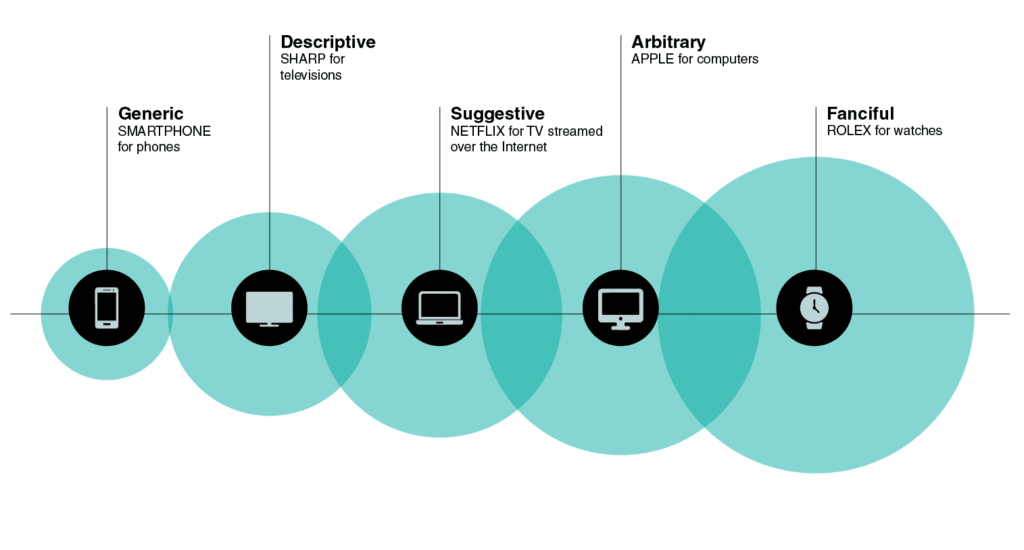A trade mark is anything that distinguishes your goods or services from those of others. It can be a word, logo, slogan, shape, colour, sound, or even a smell!
Trade marks act as your badges of origin. Just like a school badge shows which school a student belongs to, a trade mark is how customers identify you and your products or services.
They are also the vehicles for your brand – the feeling someone gets when they hear about your business or products, shaped by every interaction a person has had with or about you. That brand impression plays a big role in whether they choose to buy from you.
Your brand is your key business driver and could very well be your most valuable asset – in 2024, the Apple brand alone was valued at about a half a trillion dollars!
Choosing a distinctive trade mark is critical to building this kind of brand equity. After all, how can consumers build a connection with you if they don’t know who you are or can’t tell you apart from your competitors?
Think about it:
- A customer recommends you to a friend but they mishear or can’t remember your name and confuse you with a competitor.
- Your name’s too generic and customers looking you up on Google can’t tell which is your website.
- Your invoice gets delayed because your name is too close to another vendor in the client’s system.
Why descriptive trade marks can be a problem
A trade mark registration is a powerful way of ensuring you are the only one who can use your trade mark, as a registration gives you the exclusive right to use your registered mark for the goods and services in the registration (or similar).
However, the Intellectual Property Office won’t let one trader monopolise everyday descriptive words that others might need to use. So, if you apply to register a trade mark that’s not distinctive enough, it may be refused registration, leading to delays, objections, and extra costs.
In addition, even if you continue using the trade mark without a registration, you’ll find it harder to enforce your rights or stop others from using something similar if your trade mark is not distinctive.
Distinctive trade marks are therefore:
- Easier to register
- Easier to enforce
- More valuable as brand assets, because brand recognition is easier to establish
- Less likely to conflict with someone else trade mark(s)
The spectrum of distinctiveness
Coming up with a strong, original trade mark can be tough. A helpful way to approach this is to think about distinctiveness as a spectrum, ranging from marks that are too generic or descriptive to marks that are fanciful and easily registrable as shown in the diagram below.

Understanding where your proposed mark falls on this spectrum can help you make smarter choices before you invest time, money and energy into your brand development.
The ideal trade mark falls between the suggestive and the fanciful end of the distinctiveness spectrum, but it can be a fine balance between wanting distinctiveness and also wanting to give your consumers a hint about what it is you offer.
- Generic marks
These are words commonly used to refer to the goods and services themselves – like ‘bread’ for bread. They are unable to distinguish one traders’ products or services from another and cannot be registered.
Some trade marks can start out as distinctive but become an everyday word for a product, like ‘band-aid’, ‘frisbee’, and ‘bubble wrap’. These were all once registered trade marks, but have become generic due to widespread use, and no longer function as trade marks. To avoid this happening, it is important to actively prevent unauthorised use of your mark when you spot it.
- Descriptive marks
These describe a characteristic or quality of the goods and services – like “Tasty Snacks” for snack foods. These marks are not inherently distinctive and generally not registrable.
That said, they can be registered if they’ve become distinctive through extensive use and promotion – a concept known as acquired distinctiveness where average consumers come to associate a mark with a particular trader. Think ‘Booking.com’ for booking/reservation services and ‘Kentucky Fried Chicken’ for fried chicken that was originally sold in Kentucky.
- Suggestive marks
These hint at the quality or characteristic of the goods and services without explicitly describing them, leaving room for interpretation and inviting consumers to make the connection. These marks are typically distinctive and registrable, and also commercially effective.
Examples include ‘Netflix’ for streaming services and ‘KitchenAid’ for kitchen appliances.
- Arbitrary marks
These are commonly understood words in unrelated contexts, like ‘Apple’ for computers, ‘Amazon’ for online shopping, and ‘Coach’ for luxury accessories. These marks are very distinctive and inherently registrable.
- Fanciful marks
These are made-up or ‘coined’ words, invented for the sole purpose of functioning as a trade mark. These marks are the most distinctive and are the easiest to enforce. Think ‘Rolex’ for watches and ‘Kodak’ for film and camera products.
Tips and tricks for choosing a distinctive trade mark
- Don’t rely on minor misspellings or slight variations – KOOL KLEANING SERVICES is still just “cool cleaning”.
- Be careful with place names – they won’t be distinctive where there could be a connection between the place and your products or services.
- Names or surnames are also tricky – common surnames like ‘Smith’ or ‘Jones’ won’t usually be distinctive, especially when it’s common for businesses like yours to be named after people.
- Do your research – there might be meanings or uses associated with your chosen mark that you’re not aware of, especially overseas, so check dictionaries and do some internet searches.
- Try creative combinations – adding a distinctive word to a descriptive one or even combinations of what otherwise might be descriptive words could be distinctive together.
- Consider a logo – stylisation can increase distinctiveness, especially if the words are borderline, but it’s important to remember that your rights might be restricted to that stylised form, and in some countries (like Australia) stylisation carries less weight when it comes to registrability.
- Test pronunciation and memorability – try to choose a name that is easy to say, spell and remember.
- Consider your long-term plans – avoid marks that lock you into a specific product, service or place in case you expand.
If you have any questions or need advice, please get in touch with a member of our Intellectual Property team.
Special thanks to Partner Katy Rostovitch (née Stove) and Solicitor Phoebe Calder for preparing this article.
Are you launching a new business, testing an idea, or looking to scale with confidence?
Duncan Cotterill’s Startup Hub is coming soon – a dedicated resource for founders and entrepreneurs at every stage.
From legal templates to practical insights, our hub will offer guidance tailored to your business lifecycle – helping you make the right decisions, at the right time.
Join our mailing list to stay in the loop with relevant legal updates, upcoming events, and early access to tools designed to help your startup thrive.
Join the Startup Hub mailing list
* indicates required fields
Disclaimer: The content of this article is general in nature and not intended as a substitute for specific professional advice on any matter and should not be relied upon for that purpose.






